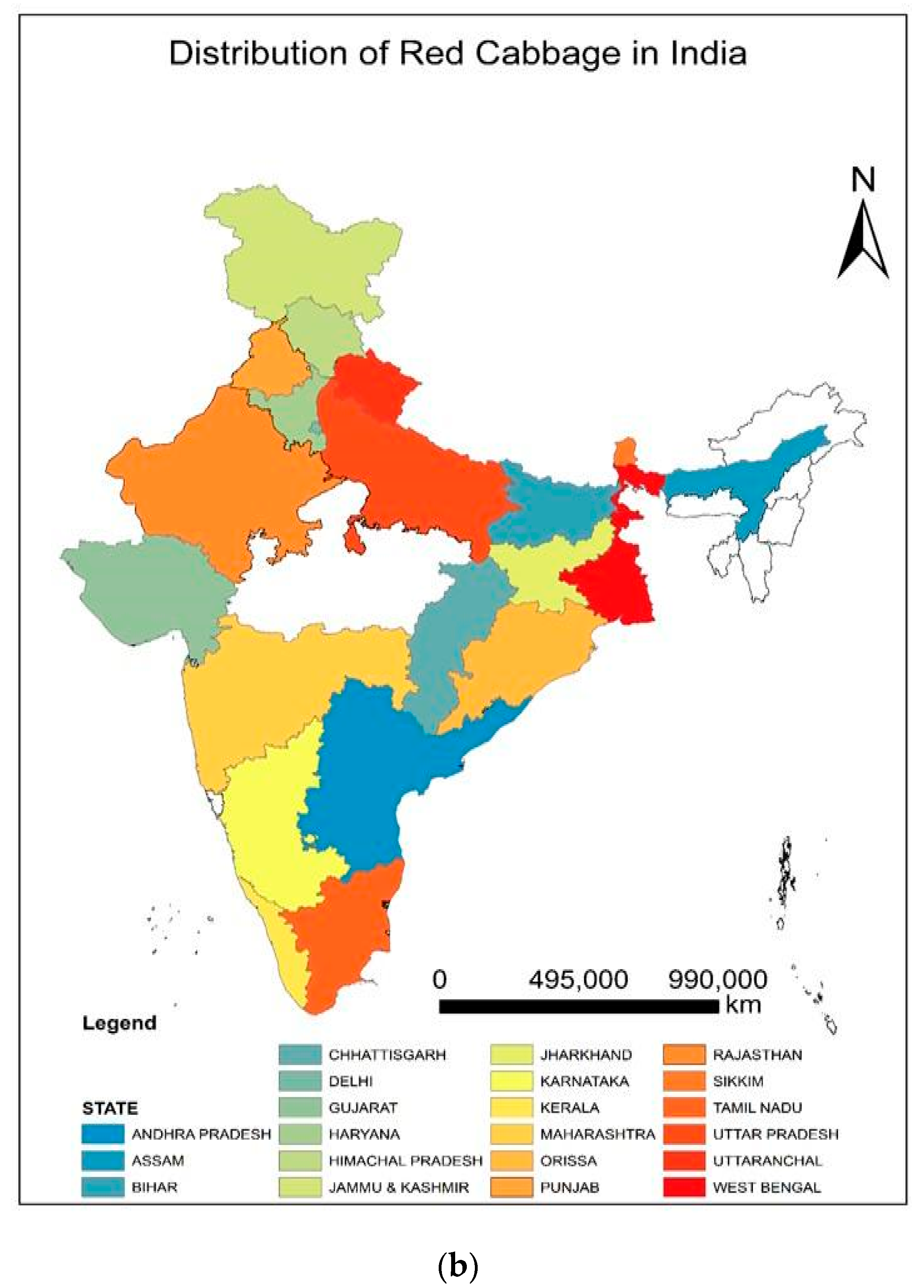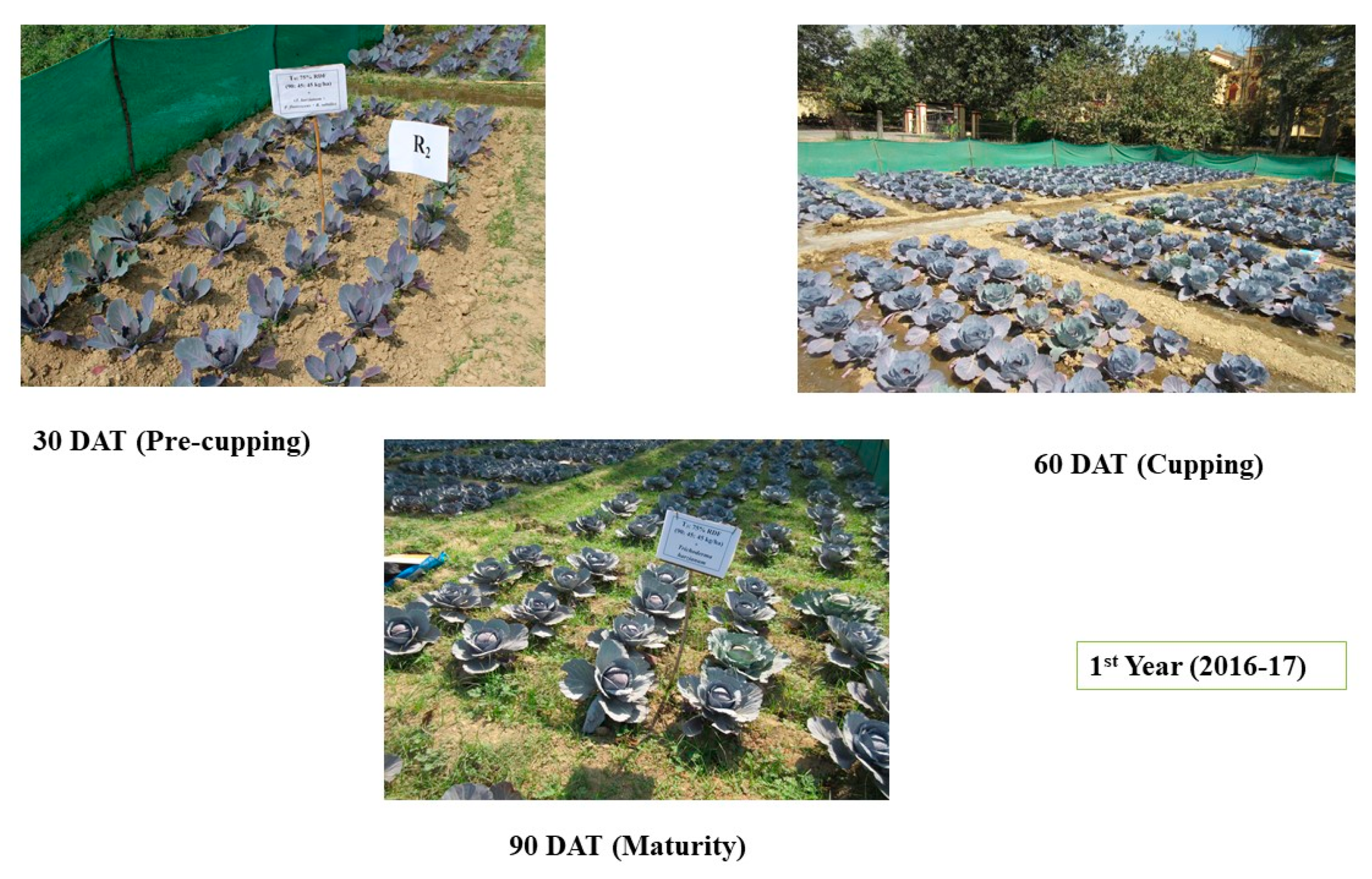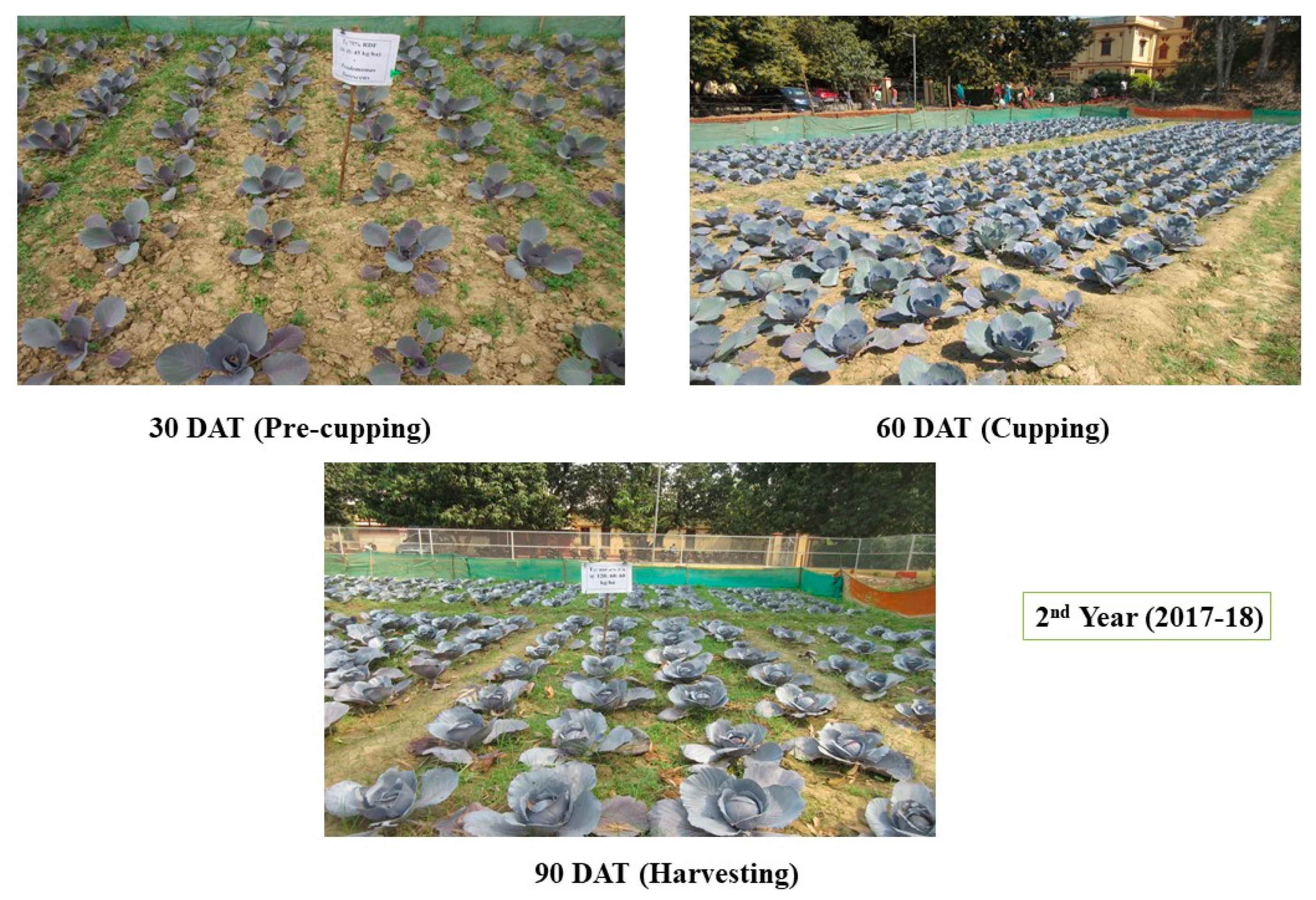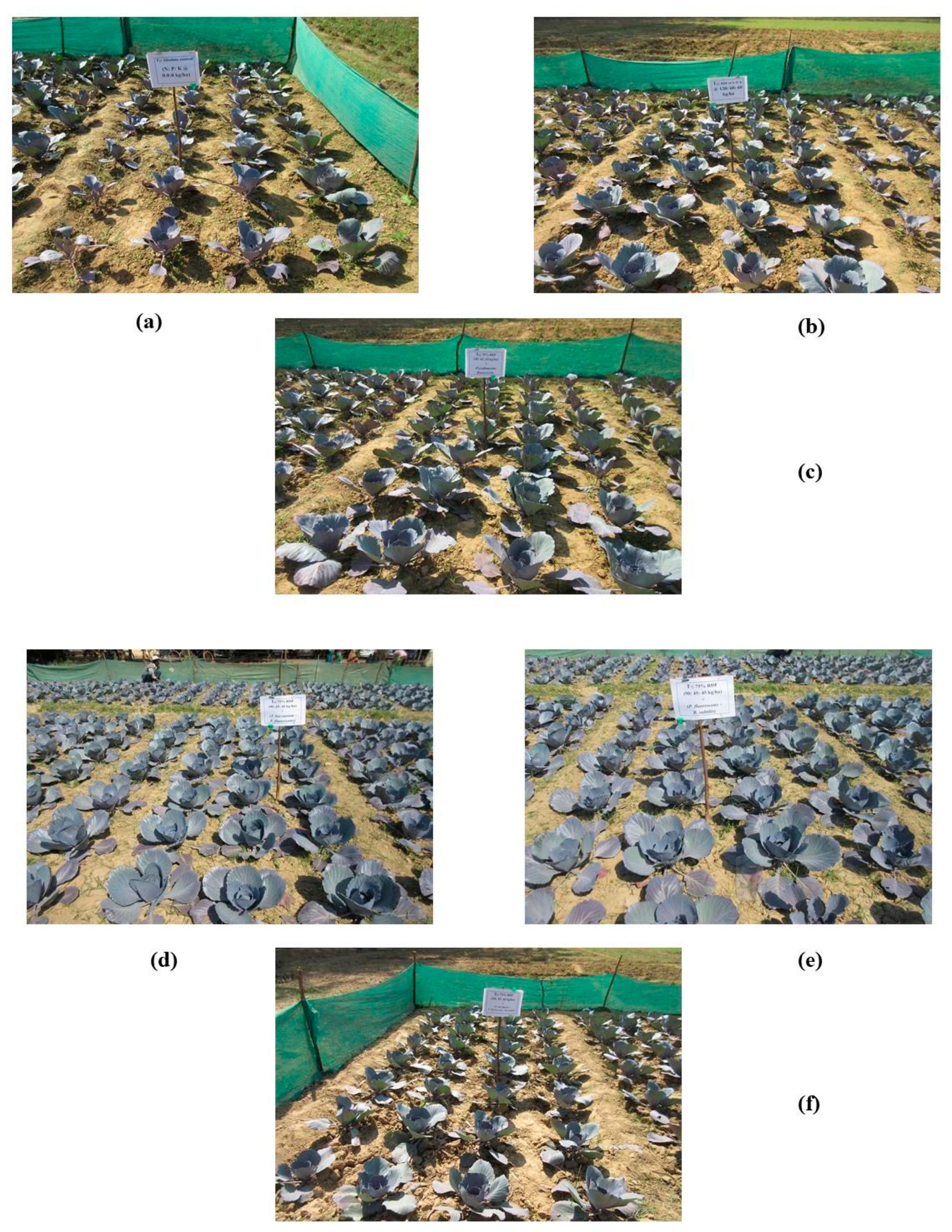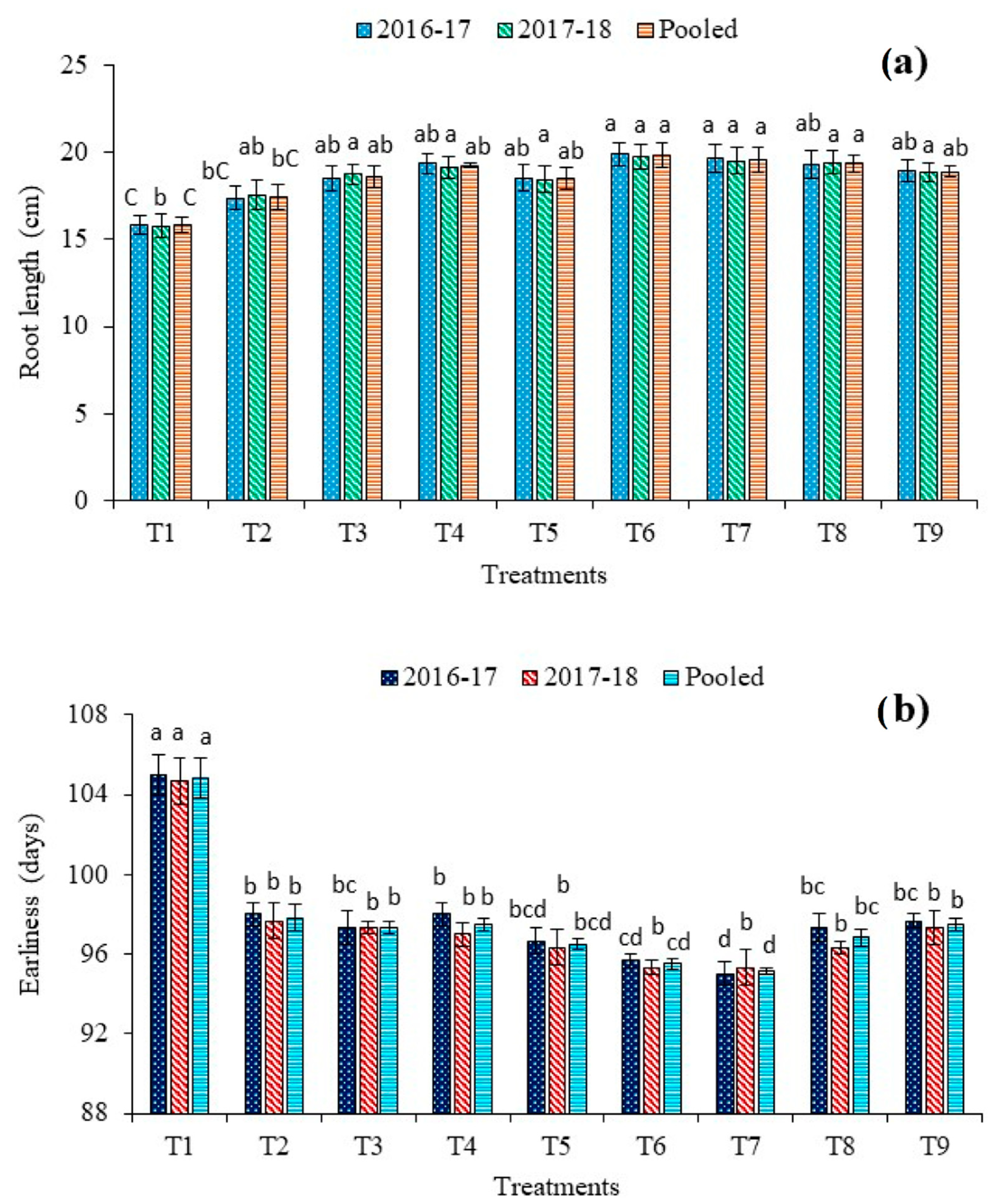1. Introduction
Red cabbage [
Brassica oleracea L. var.
capitata L. f. rubra (L.) Thell], commonly known as the modern multitasker’s dream food, has recently gained increased attention around the world. This remarkable nutritious vegetable is an excellent source of health-promoting ingredients that can boost our immune system [
1]. The choice of crops is also an important armament in our arsenal against degenerative diseases that have devastated human livelihoods and crippled the global economy. The abundance of anthocyanins, carotenoids, glucosinolates, antioxidants, vitamins (C, E, A, and K), minerals (K, Ca, Mg, Fe, and Mn), and phenols in red cabbage make it a suitable supplement for preventions against oxidative stress, cardiovascular disease, cancer, obesity, and diabetes [
2,
3]. Therefore, it is directly consumed as microgreens (
Figure 1) and salads and also cooked as a vegetable. The microgreens of this plant contain higher β-carotene (~260-fold), vitamin C (2.4−6-fold), and vitamin E (>40 times) than the matured ones [
4]. Natural dyes are extracted from red cabbage due to the presence of high levels of anthocyanins (40–188 mg Cy 3-glcE 100 g
−1 FW), which are suitable for coloring food products [
5]. The nutritional value of red cabbage is greater than white cabbage in terms of antioxidants [
6], vitamins, and minerals [
7]. This will fetch farmers higher market prices and sell their products in supermarkets [
8]. Although cole crops are native to the Mediterranean region, currently, red cabbage is cultivated globally [
3,
5] (
Figure 2a). The geographical distribution maps can highlight the crop’s popularity and direct the need for suitable production strategies to maintain sustainable agriculture. Red cabbage is grown in all of Europe [
2], North America, Asia, China [
7], Brazil [
9], South Africa [
1], Japan, and many other countries of Asia and Africa [
3,
10,
11]. Growing belts of this cruciferous leafy vegetable can be found in almost all states of India [
12,
13] (
Figure 2b).
Fertilization is an important strategy to meet the demands of the burgeoning population, which is expected to rise from the current state of 7.8 billion to 9.7 billion by 2050 [
14]. Our entire dependence on these costly chemicals has severely affected the physical, chemical, and biological properties of soil all over the world [
15]. In the case of nitrogen, poor management results in its loss in the form of volatilization (NH
3), denitrification (NO and N
2O), and leaching (NO
3−). This indicates that we should search for alternative strategies or planet-friendly food production practices that could minimize environmental pollution and ensure sustainable and profitable food production hand in hand [
16].
Rhizosphere modification has great relevance to soil fertility and plant nutrition for sustainable agriculture. The establishment of rhizo-microbiome will provide better nutrient supply, water absorption, and nutrient assimilation in plants with greater anchorage in soil [
17,
18]. Bio-priming is the best microbial delivery system because it requires a small volume of inoculums [
19]. Bio-priming is a pre-sowing treatment of plants with beneficial microorganisms [
20]. This technology triggers microbial colonization along with their proliferation in the rhizosphere which increases seedling vigour, nutrient and water uptake, systemic resistance to diverse stresses, and vegetative growth resulting in uniform stand [
21,
22]. Basically, it is a combined package covering several physiological facets and biological aspects of plant-microbe interactions. Several reports accredit plant growth promotion through modified metabolic pathways in bio-primed plants and enhanced nutrient use efficiency with changes in root architecture and other mechanisms [
8,
23,
24]. Eligible candidates of bio-priming comrpising species of
Trichoderma,
Pseudomonas,
Bacillus,
Azotobacter,
Azospirillum,
Glomus, etc., have been found to enhance plant growth [
25,
26]. Furthermore, co-inoculation studies claimed the enhancement of synergistic effects with the application of microbial consortiums, as compared to a single inoculation of bio-agents [
27,
28].
According to the latest estimate by the World Health Organization (WHO), micronutrient deficiency has affected more than 2 billion people in the world [
29]. Unfortunately, we have less provisions to track the micronutrient removal from the soil by crops. The proper evaluation of micronutrient status is very imperative because their deficiencies and toxicity range/limit in soil are narrow. Red cabbage is a nutrient exhaustive crop [
1,
8].
There are few published works on bio-primed red cabbage plants. In this backdrop, an attempt was made to examine the effect of bio-priming intervention on integrated nutrient management on growth and micronutrient uptake of red cabbage. We were also interested in monitoring the priming effect of individual bio-agent as well as the significance of a microbial consortium on the growth promotion of this exotic crop.
4. Discussion
Screening efficient microbial strains to address numerous agro-environmental challenges will help in achieving the targets of sustainable development goals. Their capacity to promote plant growth by increasing nutrient availability and acquisition has huge potential to reduce the use of chemical fertilizers in agroecosystems [
8,
26]. Moreover, they also serve as a good option to produce healthy foods and increase marketable head yield [
30]. However, the efficacy of microbial products is often found to be low under field conditions [
33]. In the current study, the effects of
T.
harzianum,
P.
fluorescens, and
B.
subtilis as single-species bio-primers and combination treatments (consortia) along with 75% RDF on crop growth and micronutrient uptake by red cabbage were studied.
At 60 DAT, the plant height (
Table 2) was the highest in 100% RDF (T
2); however, at maturity, the effect was significantly (
p ≤ 0.05) higher with 75% RDF +
P.
fluorescens +
B.
subtilis (T
7). Similar results in plant height was observed by Verma et al. [
34] due to a combined application of chemical fertilizer and organics (
Pseudomonas fluorescens + humic acid). According to Adesemoye et al. [
35], 75% RDF was the optimum rate to which the addition of bacterial inoculants (
Bacillus spp.) augmented the plant height of tomato. Recently, Houida et al. [
36] reported the increased seedling growth of maize due to seed bio-priming. The yield of red cabbage is highly dependent on the number of leaves because they act as the main site for the assimilation of carbohydrates. At 60 DAT, dual inoculated treatments (T
6–T
8) were higher in the number of leaves than other treatments (
Table 3). The increased absorption of nutrients in bio-primed plants triggered cell division, cell elongation, and overall metabolism in their system [
21]. Our findings are in conformity with the reports of Verma et al. [
34] and Thakur et al. [
37]. At maturity stage, the number of leaves was reduced in bio-primed plants, which indicated a better head formation of these plants.
The plant spread was maximum with 75% RDF +
P.
fluorescens +
B.
subtilis (T
7) at all three stages, i.e., pre-cupping, early head formation, and maturity (
Table 4). Our observations are in partial agreement with the findings of Das et al. [
12]. Chlorophyll (SPAD) was found to be highest under 75% RDF +
T.
harzianum +
B.
subtilis (T
8) at all stages (30 DAT, 60 DAT, and harvest) (
Table 5). Root system modulation in bio-primed plants led to a greater absorption of nutrients and the production of carbohydrates. However, the effect was not significant in comparison to plants receiving 100% RDF. Contrary to our results, Chatterjee et al. [
38] observed significantly higher SPAD values in cabbage due to a combined application of inorganic fertilizers and organics (organic manure and biofertilizer) in comparison to the sole application of inorganic fertilizers. However, our results are in partial agreement with the reports of Vafadar et al. [
39] who claimed positive effects of triple inoculations on chlorophyll content over single inoculations, but the effects were inferior to dual inoculations. Seed inoculation with
Bacillus megaterium enhanced chlorophyll (SPAD) by 5.8% in cabbage [
40].
During early head formation, leaf area (
Table 6) was at its maximum with 75% RDF +
T.
harzianum +
P.
fluorescens (T
6). Among single species bio-priming,
P.
fluorescens inoculated plants exhibited higher leaf area over other individual inoculated plants at all growth stages. A similar effect of
Pantoea agglomerans over
B.
subtilis was reported in cabbage by Turan et al. [
40]. However, significant (
p ≤ 0.05) variations between bio-primed plants and 100% fertilized plants were not documented. In contrast to our findings, the significant effect of bio-priming in combination with mineral fertilizer on leaf area was reported in baby corn [
19]. Furthermore, the positive effect of conjoint use of inorganic and organic biofertilization in cauliflower was also reported by Thakur et al. [
37]. Thus, the improvement in morphological and physiological parameters in the host plants are a resultant of bio-priming induced seed germination, seedling vigor, activation of enzymes, root growth, nutrient uptake, etc. [
41].
Root length is also a vital parameter that is directly linked to plant growth. In our investigation, higher root length (
Figure 5a) was recorded in 75% RDF +
T.
harzianum +
P.
fluorescens (T
6). Results also clearly suggested that bio-priming was effective in improving the root growth of red cabbage crop. The positive effect of organic and inorganic fertilizers on root length was also reported by Islam et al. [
42]. Microbial agents such as
Trichoderma have the ability to colonize the epidermis and outer cortical layers of the root and enhance root development for increasing the uptake of nutrients [
43]. However, chemotactic signals from root exudates are also responsible for root colonization [
44,
45]. The significant enhanced root length of baby corn was detected with the application of 75% RDF in combination with
Trichoderma viride and
Glomus intraradices [
19]. Increased root colonization by fungal strains (
Glomus intraradices and
Acaulospora laevis) in the presence of mycorrhiza helper bacteria (
P.
fluorescens) was recorded in broccoli plants [
46]. The minimum number of days to head maturity (earliness) was recorded with 75% RDF +
P.
fluorescens +
B.
subtilis (T
7) (
Figure 5b). Our results are in agreement with the observation of Kumari et al. [
47] and Thakur et al. [
37], who noticed a significant reduction in the number of days to maturity of cabbage head and cauliflower curd, respectively, with the use of bio-inoculants.
Results showed that bio-priming not only promoted the growth (
Figure 4) of red cabbage but also influenced micronutrient uptake (Fe, Mn, Zn, and Cu) by the head (
Table 7). The plant uptake of Fe, Mn, and Cu was the highest with 75% RDF +
T.
harzianum +
P.
fluorescens (T
6), while the highest Zn uptake was observed with 75% RDF +
P.
fluorescens +
B.
subtilis (T
7). The micronutrient bioavailability to plants is a consequence of microbial activities including siderophore production, exudation of organic ligands and organic acids, rhizospheric acidification, etc. [
48,
49]. The bacterial inoculation of
Pseudomonas spp. and
Bacillus spp. showed increased uptake of Fe, Mn, Zn, and Cu by maize plants [
50]. Modifications in root architecture, viz., higher as well as longer secondary root hairs induced by qid74 gene in
T.
harzianum-treated cucumber plants, facilitated the enhanced uptake of macronutrients and micronutrients as a resultant of the increment in total absorptive surface and, consequently, led to better plant biomass [
51]. The solubility of Zn increased due to the secretion of organic acids (citrate and malate) by rhizospheric microbes [
52]. Diffusible metabolites produced by
T.
harzianum 1295-22 (T-22) have the ability to solubilize Fe, Mn, Zn, and Cu [
53]. The increased uptake of micronutrients in bio-primed plants indicated the existence of positive interactions among the growth promotion, root colonization, and micronutrient uptake. The Fe and Mn uptake of the crop showed strong relationships (
Table 8) with chlorophyll (SPAD). The micronutrients Fe and Mn are important for photosynthesis, carbohydrate metabolism, phytohormone synthesis, and chlorophyll formation [
49,
54,
55]. Cu and Zn uptakes showed a significant relationship with root length and earliness, respectively. Zinc is essential for the synthesis of carbohydrates, protein, and phytohormones [
50,
52,
56].


